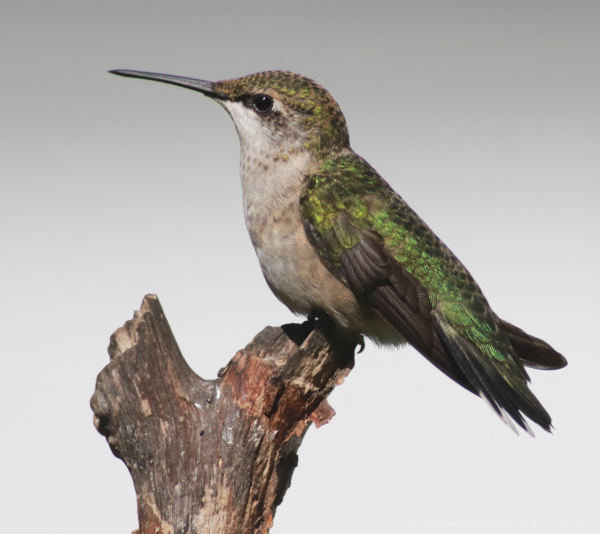
A female Orchard Oriole used a weathered birch branch as a perch before approaching a feeder, as have many other birds. By installing a perch near a feeding station, you can get a good look at birds perched in the open.

Ruby-throated Hummingbirds used this vertical branch attached to a shepherds crook as a territorial perch between feeding bouts (photos by Paul Konrad).
|
As a part of your feeding station and the area surrounding your feeders and water features, consider adding some natural perches to your yard. It’s easy, it’s helpful for birds to have a perch to stop at as they approach a feeder or bird bath, and it helps to direct birds to an open perch where they are easier to see, identify, and photograph. Perches can also add some finishing touches to your landscaping when you choose a strategic position to add a vertical branch, a natural or artificial rock, stone cairn, or an ornamental piece of driftwood or log as bird perches.
You may be surprised how quickly hummingbirds, flycatchers, bluebirds, robins, and many other birds adopt these perches, which help them watch for predators, competitors, and insect foods. A new perch will also provide a place for birds to sing territorially, or mount a chase after an intruding competitor.
Start with your feeding station; we attach a decorative bare branch from an aspen or birch tree to our metal feeding station pole and shepherds crooks. We select branches that are a couple inches taller than the metal posts or poles that birds can land on before or after feeding, drinking, or bathing. We also install a similar branch about 10 feet away for birds to perch at too. That branch can be a different length, and it may need to be anchored in some way, perhaps by attaching it to a spike inserted into the ground. You may even want to keep that perch mobile; that is, install it so you can reposition it any time.
Placing perches at different elevations is also a good plan, and with any wooden perches, it’s easy to adjust the height of them with a small handsaw. You could opt to use a tall rock (natural or artificial) or a decorative piece of driftwood as the secondary perch. While each perch provides an added element in your yard for birds to use, it also allows you to dictate where birds will perch, often in locations where they wouldn’t otherwise stop. It may be in front of a favorite window, or off a deck or patio to bring birds closer from time to time, possibly giving you better looks than before.
It’s a good option to place perches at different elevations, from 3 or 4 feet high to 6 or 8 feet, and as high as you wish to position them – just be sure they are anchored well enough to withstand high winds, and positioned so they won’t harm anything if they should fall. That’s where a perch placed in an open lawn can be a good choice. Overall, a strategically placed perch can bring birds closer to you, can emphasize clear sight lines for your to view perched birds, and they can create an incentive for a different species to spend time in your yard.
If you like to photograph birds in your yard, installing a perch in a perfect location with photography in mind can be a big plus to your success. By positioning a perch where you can sit comfortably a wait for a bird, with the sun at your back to illuminate the perched birds. And you don’t need to limit your photos to perched birds, you can also take photos of birds landing and taking flight from a perch. Try it, you will like the resulting photos!
When planning and positioning perches, be creative, and appreciate their significance to birds that visit your yard and feeding station; as well as the potential to add new landscaping elements in the form of decorative rocks, branches, and driftwood.
Share your backyard birding experiences and photos at editorstbw2@gmail.com